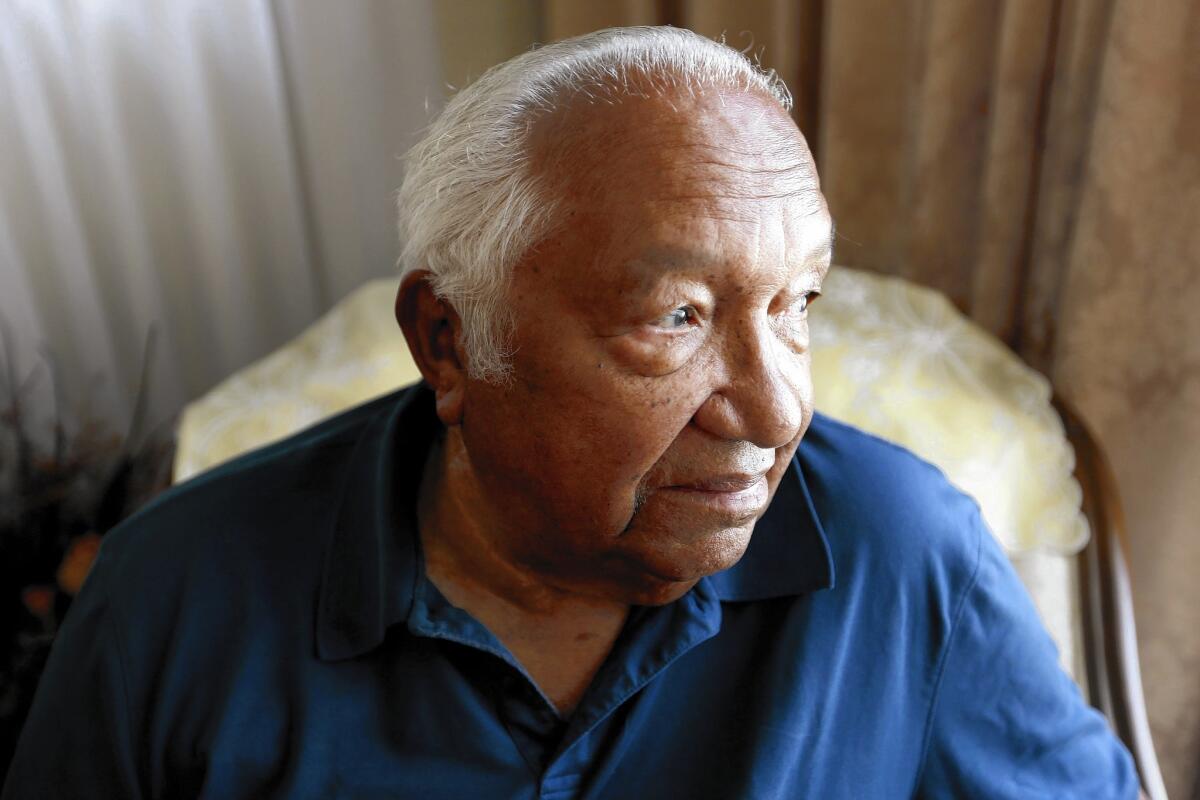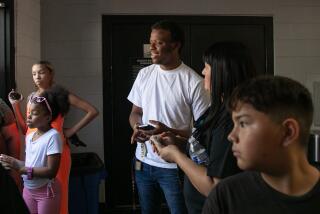Watts’ elders reflect on riots’ legacy: Too much change or not enough?

Woodrow Reed, 87, who moved to Watts in 1943, says: “Are our grandchildren doing better? I don’t think so.”
Progress can be a touchy subject for black people who came of age in South Los Angeles during the era of the Watts riots.
The uprising that started 50 years ago Tuesday exposed rampant disadvantage and raging anger — and spawned a host of programs that were supposed to remedy both.
But once the fear and sympathy of outsiders faded, the remedies evaporated. Over the next few decades, optimism was snuffed out by murderous street gangs and the scourge of crack cocaine.
“Are our grandchildren doing better? I don’t think so,” said 87-year-old Woodrow Reed, who moved to Watts in 1943 from a farm in Arkansas. He was a teen, penniless and discriminated against, but did well enough over his years to start businesses, build a home and buy several properties in Watts.
I met with Reed and a dozen others at the Willowbrook Senior Center last week. I wanted to talk about the riots, the rebellion, the uprising.…I wasn’t sure what label would resonate.
“I don’t remember what we called it,” Lavada Theus said. But she does remember driving “right into the middle of the confusion” on her way to work. People were running, throwing trash cans. Buildings were on fire. Her biggest worry was being late and losing her job.
The group had plenty of memories to share of the Watts that existed before and after the riots. Their stories made me realize how far we have come — and how far we have to go.
“I’m not cherishing the Watts riots,” Reed said. “But a lot of folks who were asleep woke up.”
Reed owned an auto repair shop in the heart of the riot zone. As the crowds gathered, he hung a “black owned” sign out front. Nearby businesses were looted and torched, but his was left untouched.
Four years later, post-riot mandates helped him get a job as a Safeway truck driver. “I was the token black for 23 1/2 years,” he said.
Some of the employees didn’t want to work with a Negro. But, Reed told them, “I didn’t come out here for you to love me. Just expect the same work out of me as you do from everybody else.
“All we ever wanted was a level playing field. We didn’t have it then. We still don’t have it now.”
::
“Government authorities have done much and have been generous in their efforts to help the Negro find his place in our society and in our economy.”
— The McCone Commission report, October 1965.
His place, our society, our economy. The language made it clear: The Negro was still an outsider in the nation his slave labor had helped build.
The commission assigned to study the riots ascribed most of its causes not to white racism, but to Negro deficiency.
And it offered scant criticism of the actual forces that made life hard for people in Watts:
State-sanctioned housing discrimination that kept black people trapped. A Police Department that relied on brutality and harassment. Businesses with “whites only” hiring rules. Labor unions that refused to let blacks join. A school system that sent teachers to Watts because no other campuses wanted them.
“We had a great athletic tradition,” said Richard Townsend, a Jordan High track and football star who graduated in 1966. But the school’s sports field had no bleachers. “No one wanted to come to Jordan to compete.”
His senior year began one month after the riots. The campus got bleachers, a new science building and money for college scholarships. Hundreds of students began the year in new clothes: booty from the riots. For many, it was first time they had worn anything that wasn’t a hand-me-down.
His senior class got attention and encouragement that previous classes had not.
“Our books had always had ‘University High’ or ‘Palisades High’ or ‘Hollywood High’ scratched out,” he recalled. “After the riots, for the first time, we got books that just said ‘Jordan.’ We were shocked.… A lot more of the students in my class went to college than before.”
Townsend became the first black graduate of UC Santa Cruz. Because his family didn’t have a car, one of his teachers — Sam Anderson, a Jordan alum — had driven him up for a visit.
The kind of commitment wasn’t unusual. That part of the story is often overlooked in the tale of Watts.
Townsend, 66, is an attorney, still married to his high school sweetheart — the girl who let him copy from her paper in geometry class.
He points out that the teachers who shaped his life were white as well as black.
Like Sue Welsh, the “white lady” students at Markham Junior High had adored. She pushed Townsend and his classmates to create the Student Committee for Improvement in Watts.
“She gave us a vision of Watts … that focused on getting people involved and making things better,” he said.
Years before the riots, the student group hosted cleanup projects, painted neighborhood houses and made repairs to the Watts Towers.
Its members organized petition drives to shut down a motel that catered to heroin addicts and a theater where rowdy young men engaged in post-movie fights.
Once at Jordan High, they kept preaching civic pride. They had planned a parade along 103rd Street for a Saturday in August 1965 — a weekend that wound up obliterated by violence.
::
Some Watts residents found paths out of poverty, once the rubble cleared.
Theus mourned the destruction of the Safeway market on Imperial Highway. “We’d worked so hard to get a major market,” she said. “And then we destroyed it.”
But the riots also bumped her family into the middle class.
She enrolled in college, became a teacher and earned two master’s degrees, while her husband moved from parking lot attendant to engineer — through an apprentice program that previously was off limits to blacks.
Still, none of that put them out of racism’s reach.
Years later, when they went house-hunting, the couple learned that skin color still mattered, maybe more than money.
“I’m a college graduate, he’s a working professional. We were making $5,000 a month, had two cars,” Theus said. They wanted to buy a house in Downey, but Downey was closed to blacks.
“We just kept getting turned down. They wanted more money, more paperwork, more answers to questions they’d already asked.” The couple settled for renting in Carson instead.
The experience “was a reality check,” Theus said. “You realize things really hadn’t changed.”
Today, Watts’ elders wonder if things have changed too much.
Factories goaded by the riots into hiring blacks eventually shut down or moved out, making it hard for high school grads to find a decent job.
A drug epidemic ripped the guts from once-stable neighborhoods, landing fathers behind bars, turning mothers into addicts and sending children into the foster care system.
The rise of gangs turned residents into prisoners and simple pleasures — an evening walk, a backyard party or a late night on the front porch — into death-defying events.
“I think we lost a whole lot of pride somewhere along the way,” Reed said as the men and women around the table at the senior center nodded their assent.
I could hear the soul-searching in their voices and their stories: A son in prison, a niece in rehab, a grandson who managed to stay out of trouble, but just didn’t amount to much.
“Did we make things too easy for our children?” Theus wondered. “They don’t know what we went through. My whole life was about working and trying to get ahead.”
Her son, she said, doesn’t share that drive.
“He says: ‘Your generation did all that and it doesn’t look like it got you anywhere.’ Yet he’s living in this big house with all the comforts that I paid for. Maybe we did too much for them.”
Or maybe it’s just bad timing.
Theus remembers driving downtown to her job as a salesclerk at Bullock’s on the second day of the riots. The trip took her through chaos and angry crowds. But she didn’t stop because she wasn’t going to miss a day of work.
By the time her son was old enough to go to work, the Crips and Bloods were running things in too many neighborhoods. She pestered him to find a job at the mall, but he passed on the interview.
The mall was “red” and the neighborhood he was coming from was “blue.”
Twitter: @SandyBanksLAT
MORE ON WATTS RIOTS:
Full Coverage: Watts Riots remembered
Editorial: 50 years after Watts riots, not enough has changed
Traffic stop was the spark that ignited days of destruction in L.A.
More to Read
Start your day right
Sign up for Essential California for news, features and recommendations from the L.A. Times and beyond in your inbox six days a week.
You may occasionally receive promotional content from the Los Angeles Times.







